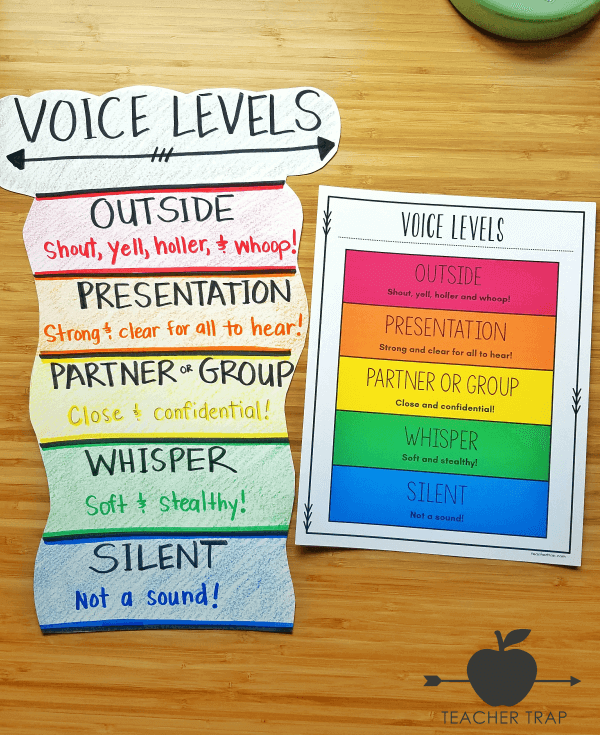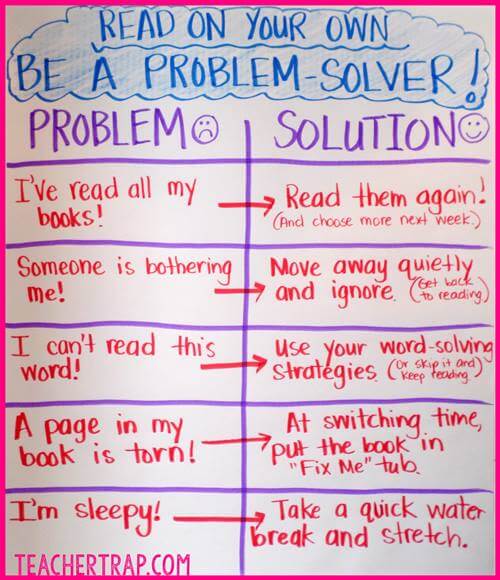The Student Continues to Talk Through the Whole Class
 If you're frustrated with your students' talking, you're not alone! In my Facebook Group (The Classroom Management Club), "too much talking" is the number one issue that teachers mention when they join. But there's good news! This classroom management struggle may be driving you nuts, but it can be cured! In this blog post, I'll share six easy strategies for fixing this problem FAST!
If you're frustrated with your students' talking, you're not alone! In my Facebook Group (The Classroom Management Club), "too much talking" is the number one issue that teachers mention when they join. But there's good news! This classroom management struggle may be driving you nuts, but it can be cured! In this blog post, I'll share six easy strategies for fixing this problem FAST!
Before we get started, I want to make a distinction between two types of talking. The "driving-me-crazy" talking we'll be focusing on here includes students blurting out, side-conversations, off-topic discussions, and all that general wrong-time, wrong-place chatter that often goes on in classrooms. This should not be confused with the oh-so-important academic discussions, enriching conversations, and endless questions that indicate a thriving learning environment. We WANT students talking, but we want them talking about the right things! So how do we help students save the social chatter for social times and keep them focused on their learning during lessons?
Kids Need to Talk
First, before we dive into the strategies, let's remember that kids NEED to talk. (Some more than others.) If you take an honest look at your school day, how often do students have the opportunity to talk in an unstructured and more social way? If the answer is "lunch and recess," then you are setting yourself up for endless frustration! My recommendation is to make sure students have at least a few minutes of "free talking time" every 1-2 hours throughout the day. If your lunch, recess, and Specials times are evenly spaced throughout the day, you might be good, but often there are long stretches of purely academic times with no break in sight! I like to schedule movement breaks throughout the day and students know that these are also FREE TALKING times! 🙂
Talking Habits Die Hard
For some students, talking is simply a HABIT. If a child comes from a home where people talk a lot, interrupt each other, or just have a lot of noise or music, talking is simply their modus operandi. It might even feel a bit uncomfortable to them when the classroom is too quiet. The strategies I'm sharing here can help to retrain children to feel comfortable and capable in a quiet setting! But practice will be necessary!

Six Strategies to Fix Talking-Troubles FAST
1. No-Talking Training
The idea of "silent time" is surprisingly elusive to many students. As mentioned earlier, noise and talking might just be a part of that child's norm, or the student may have been in a previous classroom where the teacher had very loose expectations and so ended up training the kids to talk whenever. Either way, the first step is to get clear on your expectations.
My favorite way to do this is by practicing the different Voice Levels. At the beginning of a new school year, we do this every morning for about a minute, tapering off as the school year wears on or as the kids get the hang of it. It's easy:
- Display your Voice Level Chart. (FYI, the one shown is free to download for members of the Classroom Management Club Facebook Group!)
- Pick a song, chant, or anything your students have memorized. (The ABC's, the Pledge of Allegiance, skip-counting by 5's, etc.)
- Students say it aloud while you point to different levels on the Voice Level Chart and adjust their volume accordingly. (For "Silent," students should continue the song or chant in their head!)

This quick and fun activity helps students understand and practice the different volume levels. Once they get the hang of it, I like to work on building "Silent Stamina." Whenever we are doing an activity that requires silence, I make sure to set the timer and see how long we can maintain a truly SILENT classroom. This builds awareness and helps students master the art of silence.
2. Silent Time Set-Up
There are certain times when we'd like students to stay truly silent, such as during a test or independent work, or when we're giving instructions. Often, we launch into these activities without giving clear expectations. Don't assume that students know you expect silence during these times! (Unless you love to suffer…) Instead, set clear expectations every single time and include these 3 components:
- Time Period: For the next __ minutes, I'll need everyone to be silent.
- Expectation Reminder: Let's remember that silent means no voices, sounds, or disruptions.
- Reason: Our goal right now is to give everyone a quiet room so you can focus on this work and do your best.
By setting a clear time period, students know how long they'll need to maintain silence and that there is an endpoint! Without an endpoint, staying silent may seem impossible to many children and they won't even try. You'll also want to be realistic about the goal. I find that in the beginning of the school year, elementary-aged children can only stay silent for 10-15 minutes, but with practice can quickly build up to 45 or more. It's also incredibly helpful to give them a REASON for being silent. Help them understand the purpose, and you'll get better results.

3. Model the Mood
When I was working as an Instructional Coach, I was in and out of different classrooms all day long. One of the curious things I witnessed again and again was this:
A teacher would set up an activity and explain that students were expected to stay silent. As the children began working, the teacher would begin talking – talking to a student, shouting across the classroom, talking to me or another teacher, etc. The teacher's loud talking would completely disturb the quiet mood of the room, and eventually students would begin talking, as well, at which point, the teacher would then loudly reprimand the talkers and complain that the class wouldn't stay quiet.
It was an endless cycle of the teacher demanding quiet, modeling the opposite until students followed suit, and then demanding quiet again. Let's face it, the old adage "Do as I say, not as I do," doesn't work!! If you want your students to stay calm and quiet, YOU must model that.
During silent work times, make sure that YOU are using a whisper voice and modeling the calm mood you're trying to create. If students begin talking, use a silent signal to remind them to stay quiet, or walk over and place a silent hand on the student's shoulder. When students see you maintaining the quiet, they will, too!
4. Pre-Problem-Solving
One of the things that often brings about talking during silent times is that students have problems they don't know how to solve. They end up distracted from their purpose, asking a neighbor, or looking to you for help. You can avoid a lot of this by doing some problem-solving with the class beforehand. Simply think of potential issues that might arise (or have students help you think of them), and jot down what to do in this situation. You can do this for general quiet work times, or create charts specific to different parts of the day.

If you notice students off-task or looking for help, you can point to your handy chart rather than speaking or responding to them.
5. Habit Hijack
As we mentioned earlier, talking is often a habit, and some students honestly feel more comfortable when there is background noise or commotion. One of the easiest ways to address this challenge is to play calming music during silent work times. The music fills the silence that might make some kids uncomfortable, and acts as a reminder that we're currently in a silent work time. You can even say, "We'll be working in silence for 20 minutes. You'll know our time is up when the music ends." The key is to choose music that is instrumental (no words) and that sets that calming mood in the classroom.
My students and I became obsessed with these piano covers of popular songs (affiliate links):
(NOTE: I created a playlist on my computer and LEFT OUT any songs that included inappropriate topics or bad words. Even though these are instrumental, kids often still know the words and I didn't want to risk having someone sing-along to the wrong thing!)
6. Reap the Rewards
If you have tried all of the above and students are still struggling to monitor their own talking, I have one last strategy that can give students that added push. If you're about to begin an activity that requires sustained silence, build in a potential "Talk Break" at the end of the activity, and let students know they can earn that time.
For example:
For the next 30 minutes, we'll be working in silence on our math tests. Even if you finish your test, you'll need to stay quiet. If everyone can stay quiet and focused for this time, the class will earn a 5 minute "Talk Break."
I like to have built-in Talk Breaks that students can earn every single day. This also lets students know that there WILL BE time to talk, so if they are dying to tell a friend something, they know they just have to save it until that time.
What About Blurts?
Blurters are a special kind of talker that require a specific strategy. If you're struggling with students who continually yell out thoughts or questions, there is hope for you, too!
Over the years, I've tried A LOT of different strategies to deal with blurters. I had very little success until this idea came along. And to my utter surprise, it WORKED!
Here's what you do:
- Draw a square on the white board and label it "Blurts."
- Every time a student blurts out without raising their hand, point to the chart. They need to quietly walk over and add a tally to the chart. (No discussion needed.)
- At the end of the day, count up the blurts.
- Each morning, review the number of blurts from the day before and set a new goal. (In the beginning, our goal was simply to have less blurts than the day before. Later, our goal was 'less than 3 blurts a day.')
- Track progress and make a plan for celebration if a goal is met. For example: If we can stay under 3 blurts a day for the week, we'll earn a 15 minute Blurt Party on Friday where you can talk all you want!
Why does this work? First, blurting is a habit, just like talking all the time. By tracking the blurts, we are building awareness of the habit so students can begin to see what is happening. Second, it's a team effort. Because the goals are CLASS goals, the students want their classmates to succeed. They often begin reminding each other, and even keeping an eye on the serial-blurters, reminding them to raise their hand. Third, it allows the teacher to stay calm and focused on teaching! Rather than getting frustrated and letting blurts derail a lesson, you simply point to the sign and move on.
When I did this with my chatty class of third-graders, we had 51 blurts the first day! By the second day, we were already down to 22, and by the third day our goal was less than 10. The next week, we set our goal at less than 3 a day and managed to earn a Blurt Party on Friday. I could not believe how well this strategy worked for my students and I LOVED that I was no longer wasting my energy fighting against all the interruptions.
Join the Club
As I mentioned earlier, I share exclusive downloads and handy tips with my Facebook Group: The Classroom Management Club. If you're looking for ongoing support, check it out!

Talkative students can drive us nuts, but with a little bit of training and some clear expectations, HUGE changes are possible! I'd love to hear more about what works for you when dealing with a chatty class!

broughblithical1978.blogspot.com
Source: https://www.teachertrap.com/2018/04/students-talking-too-much.html/